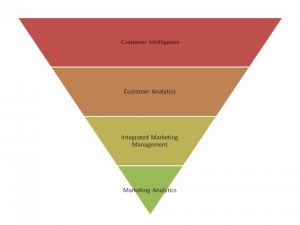 In the first post in this series, I introduced the collection of terms that describe how organizations manage their customer engagements: customer intelligence, customer analytics, integrated marketing management and marketing analytics. It's important to define them, as well as understand what comprises each term and which SAS solutions apply. It's also important to know the reasons that these terms (or processes) are different and distinct. We previously highlighted the term Customer Intelligence and detailed out its place in the market.
In the first post in this series, I introduced the collection of terms that describe how organizations manage their customer engagements: customer intelligence, customer analytics, integrated marketing management and marketing analytics. It's important to define them, as well as understand what comprises each term and which SAS solutions apply. It's also important to know the reasons that these terms (or processes) are different and distinct. We previously highlighted the term Customer Intelligence and detailed out its place in the market.
Today, let's focus on our second term: Customer Analytics.
The term Customer Analytics refers to the processes and technologies that give organizations the customer insight necessary to deliver offers that are anticipated, relevant and timely. It is the practice of analyzing customer data in order to find underlying patterns, behaviors, or insights. As the backbone for all organization-to-customer activities, customer analytics comprises techniques such as predictive modeling, data visualization, information management and segmentation. They make up the building blocks to the comprehensive customer intelligence solutions, and in the house construct analogy of the previous post, customer analytics would be found in the foundation.
Customer Analytics takes the second spot on our visual because it is narrower and more analytically focused than customer intelligence initiatives. It might be helpful to think of customer analytics as akin to the process of baking a cake. The end result of customer analytics programs would be the finished cake, while the technologies are the ingredients that make up the cake!
These processes refer to the end goals (or finished cake) of customer analytics programs:
- Improve my data quality process.
- Strengthen my segmentation process from the macro to micro level.
- Manage my modelling process more efficiently in order to avoid rework.
- Clarify my sentiment analysis and influence scoring processes.
- Create a more robust customer profile
These technologies refer to the individual components (or ingredients) needed to accomplish customer analytics programs:
- Base SAS & STAT
- Enterprise Miner with Rapid Predictive Modeler
- Model Manager
- Text Analytics
- Forecast Server
- Content Categorization and Sentiment Analysis
- Scoring Accelerator
- Social Network Analysis Server
- JMP Software
- Visual Analytics
While Customer Analytics are not the slick and sexy marketing solutions that sit on top of your data warehouse, they are usually the trusty implements that get the job done for specific, defined customer data problems. Using the cake baking analogy, customer analytics are the spatulas, non-stick pans and well-worn measuring cups that get the job done when you're faced with a specific problem to solve. In the world of business software, customer analytics are not as broad as customer intelligence, but are not limited to marketing activites and therefore are not as narrowly defined as marketing analytics.
SAS Customer Analytics are a mainstay for many of our customers, solving some thorny customer data issues that you may be also be faced with:
- Verizon unleashes the power of customer analytics to transform relationships and generate growth.
- HP harnesses big data and turns 2.5 billion transactions into intimacy using customer analytics.
- Grameenphone reduces churn via customer analytics in order to grow revenue.
- Gilt Groupe uses customer analytics to pioneer a new way to shop for high-end luxury goods
Stay with me, as the next post will dive into the integrated marketing management term! In the meantime, please comment with your thoughts! Thank you for following!
